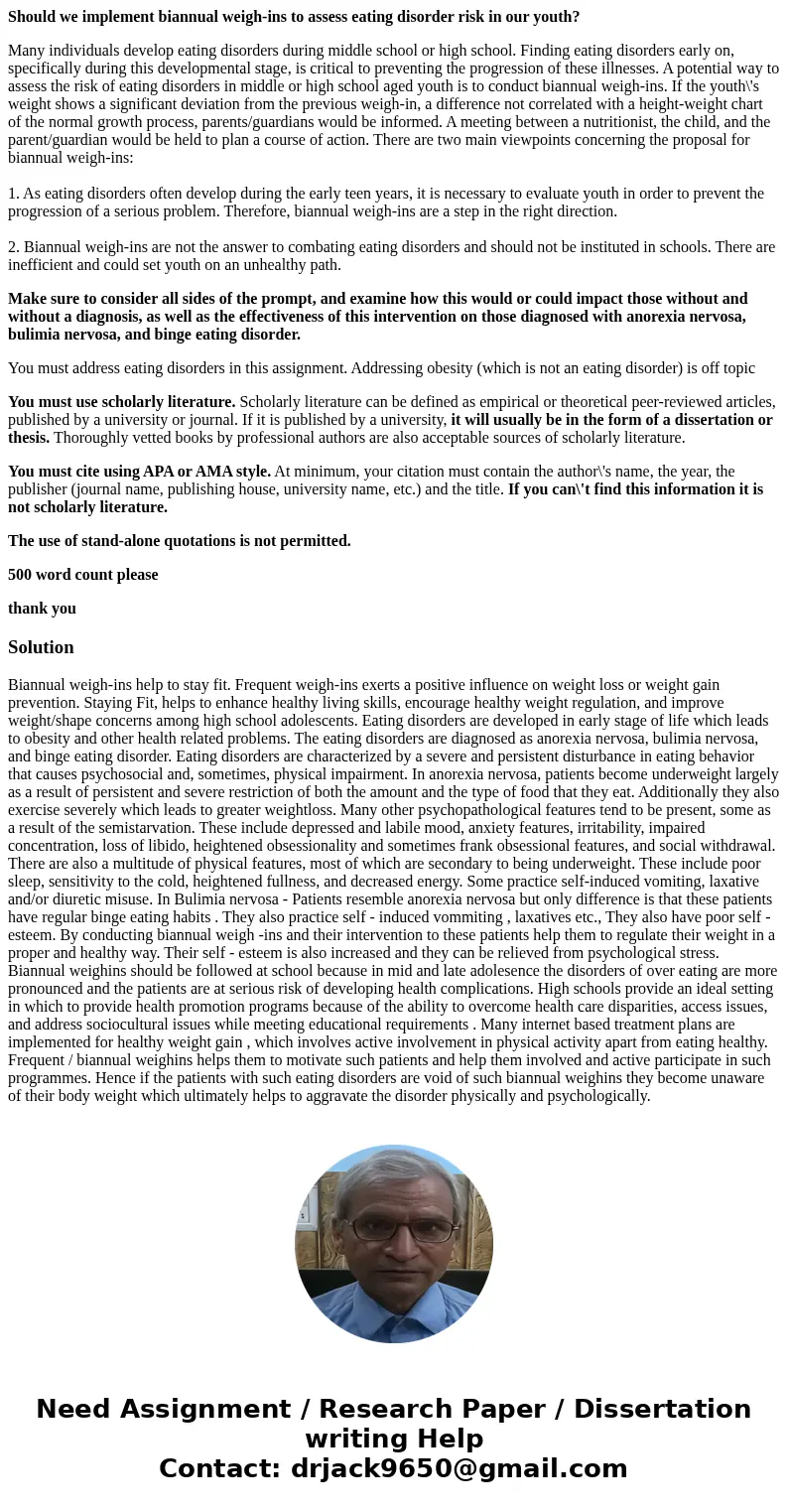Should we implement biannual weighins to assess eating disor
Should we implement biannual weigh-ins to assess eating disorder risk in our youth?
Many individuals develop eating disorders during middle school or high school. Finding eating disorders early on, specifically during this developmental stage, is critical to preventing the progression of these illnesses. A potential way to assess the risk of eating disorders in middle or high school aged youth is to conduct biannual weigh-ins. If the youth\'s weight shows a significant deviation from the previous weigh-in, a difference not correlated with a height-weight chart of the normal growth process, parents/guardians would be informed. A meeting between a nutritionist, the child, and the parent/guardian would be held to plan a course of action. There are two main viewpoints concerning the proposal for biannual weigh-ins:
1. As eating disorders often develop during the early teen years, it is necessary to evaluate youth in order to prevent the progression of a serious problem. Therefore, biannual weigh-ins are a step in the right direction.
2. Biannual weigh-ins are not the answer to combating eating disorders and should not be instituted in schools. There are inefficient and could set youth on an unhealthy path.
Make sure to consider all sides of the prompt, and examine how this would or could impact those without and without a diagnosis, as well as the effectiveness of this intervention on those diagnosed with anorexia nervosa, bulimia nervosa, and binge eating disorder.
You must address eating disorders in this assignment. Addressing obesity (which is not an eating disorder) is off topic
You must use scholarly literature. Scholarly literature can be defined as empirical or theoretical peer-reviewed articles, published by a university or journal. If it is published by a university, it will usually be in the form of a dissertation or thesis. Thoroughly vetted books by professional authors are also acceptable sources of scholarly literature.
You must cite using APA or AMA style. At minimum, your citation must contain the author\'s name, the year, the publisher (journal name, publishing house, university name, etc.) and the title. If you can\'t find this information it is not scholarly literature.
The use of stand-alone quotations is not permitted.
500 word count please
thank you
Solution
Biannual weigh-ins help to stay fit. Frequent weigh-ins exerts a positive influence on weight loss or weight gain prevention. Staying Fit, helps to enhance healthy living skills, encourage healthy weight regulation, and improve weight/shape concerns among high school adolescents. Eating disorders are developed in early stage of life which leads to obesity and other health related problems. The eating disorders are diagnosed as anorexia nervosa, bulimia nervosa, and binge eating disorder. Eating disorders are characterized by a severe and persistent disturbance in eating behavior that causes psychosocial and, sometimes, physical impairment. In anorexia nervosa, patients become underweight largely as a result of persistent and severe restriction of both the amount and the type of food that they eat. Additionally they also exercise severely which leads to greater weightloss. Many other psychopathological features tend to be present, some as a result of the semistarvation. These include depressed and labile mood, anxiety features, irritability, impaired concentration, loss of libido, heightened obsessionality and sometimes frank obsessional features, and social withdrawal. There are also a multitude of physical features, most of which are secondary to being underweight. These include poor sleep, sensitivity to the cold, heightened fullness, and decreased energy. Some practice self-induced vomiting, laxative and/or diuretic misuse. In Bulimia nervosa - Patients resemble anorexia nervosa but only difference is that these patients have regular binge eating habits . They also practice self - induced vommiting , laxatives etc., They also have poor self - esteem. By conducting biannual weigh -ins and their intervention to these patients help them to regulate their weight in a proper and healthy way. Their self - esteem is also increased and they can be relieved from psychological stress. Biannual weighins should be followed at school because in mid and late adolesence the disorders of over eating are more pronounced and the patients are at serious risk of developing health complications. High schools provide an ideal setting in which to provide health promotion programs because of the ability to overcome health care disparities, access issues, and address sociocultural issues while meeting educational requirements . Many internet based treatment plans are implemented for healthy weight gain , which involves active involvement in physical activity apart from eating healthy. Frequent / biannual weighins helps them to motivate such patients and help them involved and active participate in such programmes. Hence if the patients with such eating disorders are void of such biannual weighins they become unaware of their body weight which ultimately helps to aggravate the disorder physically and psychologically.
 Homework Sourse
Homework Sourse